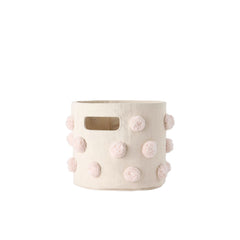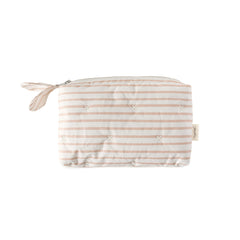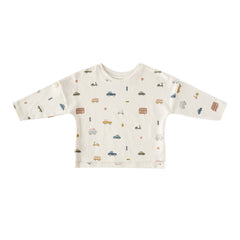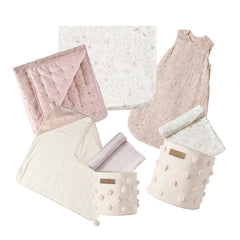Parenthood is a beautiful thing but as any new mom or dad will tell you, things can get a little messy along the way. From spit-up to sneezes, it’s pretty easy for germs to spread quickly in a household with little ones. While colds and flus are inevitable, it’s great to have some tips and tricks up your sleeves to help keep them at bay. One of the most effective ways to tackle germs is by keeping your little one’s playthings clean. In this article, we’ll walk you through how to clean baby toys safely and effectively. Whether you are tackling a plush toy, a wooden toy, a plastic toy or an electronic, we have easy tips and tricks!
Table of Contents
- Why should you clean baby toys?
- How often should I clean baby toys?
- How to clean baby toys
- Tips & tricks for how to clean baby toys
Why should you clean baby toys?
Babies love to explore their surroundings. Everything they see is new and exciting and their brains are constantly working to make sense of the world around them. If you’ve ever observed a baby playing, you know that they want to touch everything they see and they love to mouth their toys. So, it’s fairly easy for germs and bacteria to end up all over your little one’s play things. With new immune systems and narrow airways, babies are highly susceptible to catching colds and flus that can be passed on to other family members. So, it’s in everyone’s best interest to keep baby toys clean and illnesses at bay.

How often should I clean baby toys?
Many parents wonder how often they should be cleaning their baby’s toys. The answer is that it really depends on the type of toy and how often they use it. Here are a few things you can keep in mind when determining how often to clean a toy:
- Teething rings and pacifiers should be cleaned daily. If the ring or pacifier has been dropped on the floor, be sure to clean it before giving it back to your child.
- Plastic toys that are used often, or that your child likes to put in their mouth, should also be wiped down or cleaned regularly. You can aim for daily or weekly cleaning for these toys.
- Plush toys that your child sleeps with should be washed every week or every other week. These can often be put in the washing machine with other clothing items. Read the washing instructions before cleaning so you don’t run the risk of ruining your little one’s toy.
- Electronics screens and keyboards should be wiped down weekly or more often if a family member is or has been sick recently.

How to clean baby toys
When it comes to cleaning baby toys, the process varies depending on the type of toy you’re dealing with. So, we’ve broken this down into step-by-step instructions for how to clean plush toys, wooden toys, plastic toys and electronic toys.
How to clean plush toys
- Check the washing instructions on the plush toy to see if it can be machine-washed.
- If it can, place the toy in the washing machine and select a delicate cycle so you don’t damage the toy, using a gentle detergent. For added protection from damage, you may also want to place the plush toy in a mesh bag.
- If the toy can’t be machine washed, you can wash it by hand. Fill a bucket with warm water and a gentle detergent, submerge the toy and gently wash it. Rinse out any soap with warm water.
- You may be able to put plush or fabric toys in the dryer. If you do, be sure to select a delicate cycle. If you’re concerned about damaging the item, air-drying is usually the safest option.
How to clean plastic toys
There are a few different options for cleaning plastic toys. Let’s walk through them one-by-one:
- You can submerge plastic toys in a bucket filled with warm water and dish soap or another cleaning solution of your choosing. Wash the toys like you would wash dishes and then lay them out to dry. Once they’re completely dry, you can return them to storage or give them back to your child.
- Alternatively, plastic toys can be cleaned by spraying them down with an antibacterial cleaning solution. Make sure you use enough, as it’s important that there is sufficient solution on the toys to keep them soaked while the product works on killing the germs. This usually takes a few minutes. Once this is done, you can rinse the toys in warm water to remove any chemicals from the cleaning solution and then let the toys air dry. Once they’re completely dry, you can return them to storage or give them back to your child.
- If the toys are dishwasher safe, you can also clean them this way. We recommend using a sanitize cycle to get rid of germs and bacteria more effectively.
How to clean electronic toys
- Turn electronic toys off before cleaning them, remove any batteries and be sure to close the battery hub.
- Make a cleaning solution with warm water and some dish soap. Wet a cloth in the solution and wring out any excess liquid.
- Wipe down the toy’s surface with the washcloth.
- To remove lingering soap, wet a second cloth with warm water and wipe down the toy again.
- Wipe the toy down with an antibacterial or alcohol wipe.
- Wet another cloth with warm water and wipe down the toy to remove any alcohol or residue from the antibacterial wipe.
- Let the toy completely air dry before returning to storage or giving it back to your child.

How to clean wooden toys
- Wooden toys should never be submerged in water, as soaking can cause damage.
- Instead, you can spot clean wooden toys with a gentle cleaning solution. Warm water and vinegar or warm water and dish soap will usually do the trick.
- Wet a cloth in the solution and wring out any extra liquid.
- Wipe down the surface of the toy.
- Wet a second cloth with warm water and wipe down the toy again to remove any lingering soap or vinegar.
- Be sure to dry the wood right away. You can do this by removing any excess liquid with an absorptive, dry cloth and then air dry.

Tips & tricks for how to clean baby toys
- Prevention is key. Take steps to prevent germs and bacteria from ending up on your child’s toys in the first place. If your child is old enough, ask them to wash their hands before playtime or simply wipe their hands with a baby wipe or a soapy warm cloth
- Storage is important. Keeping your playroom tidy can be half the battle. Having all your little one’s toys out at once means you’ll have a lot to clean every day. Instead, store most of their toys in bins and rotate them periodically. Maybe this month your little one is really into plush toys, but next month they’re all about toy cars. Stow the plush toys away for a little while and bring the toy cars out instead. This is one of many great toy organization ideas that will help reduce clutter and keep your child excited about the toys they already have.
- Clean as you go. It’s easy to get overwhelmed with all of the items on your to-do list, so clean toys as your child is finished with them. Tackling this chore bit-by-bit is less daunting than trying to do it all at once.
- Don’t forget about play surfaces. Parents can sometimes be so focused on keeping their child’s toys clean that they forget about the play surfaces altogether. These surfaces can house just as much bacteria as the toys themselves, so be sure to wipe down or wash playmats, rugs and floors too.






